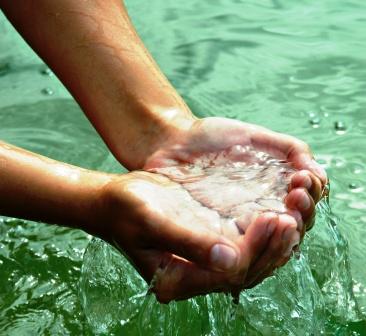Anjali Pramana: Volume Measurement As Per Ayurveda
Article by Dr Raghuram Y.S. MD (Ay) and Dr Manasa, B.A.M.S
Rachana Shaareera (anatomy) of Ayurveda has given a detailed account of the quantity and dimensions of body parts. The study of quantity of body and body parts is called ‘Pramana Shaareera’. (Pramana=Quantity, dimensions, measurements, configuration, Shaareera=Study of body, anatomy in this context).
Table of Contents
Pramana types
Pramana or body measurements or quantities or configuration or dimensions are measured in 3 ways.
1. Anjali pramana – measurement of Volume
2. Anguli Pramana – measurement of length
3. Sankhya Shareera – counts, or numbers.

Anjali Pramana
Anjali is the cavity formed by putting two hands together, such that it can hold maximum quantity of any liquid. Generally the liquid components or dhatus of the body are measured through anjali pramana. Therefore ‘Anjali Pramana’ is the unit of measurement of the liquid dhatus in the body.
Below mentioned are the measurements of some structures and tissues of the body made with the help of anjali pramana –
Udaka (water fluid compartment) – 10 Anjali
Ahara Rasa (nutritional fluid formed after the digestion of the food in the stomach and intestines) – 09 Anjali
Shonita (blood) – 08 Anjali
Pureesha (stools, feces) – 07 Anjali
Shleshma (phlegm) – 06 Anjali
Pitta (bile etc digestive juices) – 05 Anjali
Mutra (urine), Raja (artava, menstrual blood in female) – 04 Anjali
Vasa (muscle fat) – 03 Anjali
Medas (fat), Stanya (breast milk in women) – 02 Anjali
Majja (Bone marrow) – 01 Anjali
Mastishka (brain matrix) – ½ Anjali
Shukra (semen, reproductive fluid) – ½ Anjali
Shleshma (lubricants) – ½ Anjali
Ojus (essence of the tissues) – ½ Anjali
Quantifying Anjali
Anjali measurement cannot be standardized as Charaka tells that it is ‘Swena Anjali Pramanena’ i.e. the measurement is based on measuring the tissues or body fluids using one’s own anjali. The quantity which fits into each individual’s anjali (both hands joined to form a cavity) will differ.
Read related: Anguli Pramana: Linear Measurement As Per Ayurveda
Anjali is also termed as Kudava and Ardhasharava, these terms define the average quantity of the anjali pramana. 1 Kudava sums up to 4 pala i.e. 192 grams approximately. This is the quantity of sama dhatu (dhatus in a state of equilibrium) of an individual whose anjali pramana is being measured. This explains that the anjali pramana doesn’t cover the dhatus whose quantity have undergone pathological increase (vriddhi) and or decrease (kshaya).
When the above mentioned dhatus are according to one’s anjali pramana, the person seems to enjoy optimum health. Any increase or decrease would suggest pathological process which needs medical attention
Read related: Sankhya Shaareera: Count Of Body Parts As Per Ayurveda
Utility of Anjali Praman
- To determine the age or longevity of an individual (optimum anjali pramana of the drava dhatus is said to be a sign of good health and longevity)
- To determine status of health and sickness (normal anjali pramana indicates health, variations indicate sickness)
- To facilitate the treatment procedure (in case of varied proportions)
- To identify the location and size of parts of the body
- To identify the dead person
- Click to Consult Dr Raghuram Y.S. MD (Ayu)









2 comments
Arya Manoj
I was wondering how the dhathus can be measured in an individual? or to be more specific the methods used to measure the dhathus in an individual. Is it something like the prakruti assessment?
Dr J V Hebbar MD(Ayu)Author
Signs of perfect health is the sign of healthy status of Dhatu.
https://www.easyayurveda.com/2010/11/27/ayurvedic-definition-of-health-who-vs-ayurveda/
Also, we have signs for increased and decreased tissues. For example, fat tissue increase and decrease signs are explained here –
https://www.easyayurveda.com/2016/11/08/medo-dhatu-vruddhi-kshaya/
An unrelated topic is – Dhatu Sara Purusha, where a person is more dominant with one particular Dhatu (tissue)
For example, read here about person having enriched bone tissue levels –
https://www.easyayurveda.com/2020/05/08/asthi-sara-purusha-lakshanas/